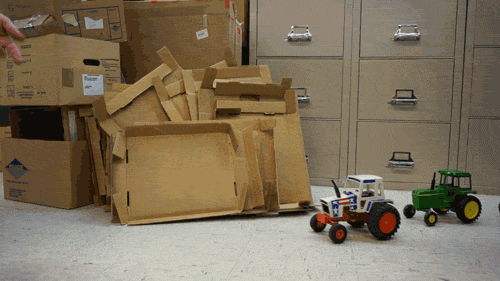2015 is coming to a close, and the SWC is looking back at some of its favorite images of the past year. (Also, because no one is in the archive for the holidays, we shamefully admit to the necessity having to recycle content!) So here they are – the best of 2015!

For example, back in July we noted that archives have nigh innumerable boxes. But when the Ag Movement tractors and I asked our Registrar to come up with a box-related joke, he replied “If they wanted us to use good grammar they should have made it more easier.” He stands by that statement to this day.

Less silly but equally entertaining is this footage of our Earth as seen through the first color satellite footage ever taken from space! Well, the footage of the earth is real. As a savvy user pointed out, however, the background and its immobile stars probably aren’t…
Every other Wednesday around here is dubbed “Western,” y’all, but sometimes we eschew the rodeos, cowboys, and ranching for a classic Ford Fairlane station wagon.
In January, we installed an exhibit on Texas Tech’s Dairy Barn, a 90-year-old symbol of the campus, still preserved today just yards away from the Southwest Collection. Here’s a photograph of it today, surrounded by our crowded campus, and then, surrounded by…pretty much nothing!
While every other Wednesday is “Western Wednesday” around here, all the remaining Wednesdays are “Map Day!” One of our most popular maps this year was, curiously, this 1988 map of historic homes and buildings in Lubbock, Texas, produced by the Lubbock Heritage Society and some of their partners.
We see many bizarre advertisements in our newspaper collections, but few are like the one we found in the spring of 1974: an obsession with streaking in Texas Tech University’s University Daily. No one knows how it started. Some say that streaking had been popular on campus for years already. Others claim that Ray Stevens’ hit, “The Streak,” which debuted in March 1974, was responsible. All we know for sure is that by the time the campus got good and warm, t-shirts featuring the logo above were widely available.
Finally, we have an image from one of our favorite blogs this year. It described our photograph collection of the Tarahumara, a people of the Sierra Madre Mountains of Chihuahua, Mexico, who’ve weathered centuries of attention by Spanish, French, and Mexican governments. They still hold on to many of their original cultural traditions. In the village of Wawatzerare, for example, this woman still carries her baby in a rebozo. This shot was snagged by Father Luis Verplancken, a Jesuit who served in Chihuahua for decades, and who created all of these photographs.
So there you have it: a taste of our favorite images of the year. Keep an eye out for next year’s stuff. It’s bound to be as good (or even better!)











